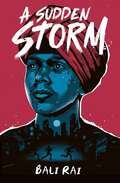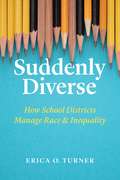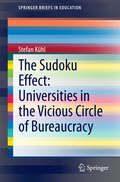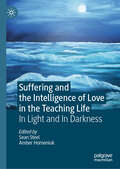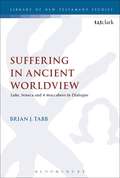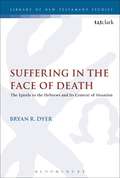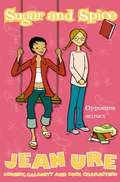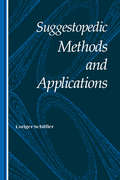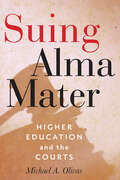- Table View
- List View
Such, Such Were the Joys: A Graphic Novel
by George OrwellOne of the most famous writers of all time, George Orwell's life played a huge part in his understanding of the world. A constant critic of power and authority, the roots of Animal Farm and Nineteen Eighty-Four began to grow in his formative years as a pupil at a strict private school in Eastbourne. His essay Such, Such Were The Joys recounts the ugly realities of the regime to which pupils were subjected in the name of class prejudice, hierarchy and imperial destiny. This graphic novel vividly brings his experiences at school to life. As Orwell earned his place through scholarship rather than wealth, he was picked on by both staff and richer students. The violence of his teachers and the shame he experienced on a daily basis leap from the pages, conjuring up how this harsh world looked through a child's innocent eyes while juxtaposing the mature Orwell's ruminations on what such schooling says about society. Today, as the private school and class system endure, this is a vivid reminder that the world Orwell sought to change is still with us.
Such, Such Were the Joys: A Graphic Novel
by George OrwellOne of the most famous writers of all time, George Orwell's life played a huge part in his understanding of the world. A constant critic of power and authority, the roots of Animal Farm and Nineteen Eighty-Four began to grow in his formative years as a pupil at a strict private school in Eastbourne. His essay Such, Such Were The Joys recounts the ugly realities of the regime to which pupils were subjected in the name of class prejudice, hierarchy and imperial destiny. This graphic novel vividly brings his experiences at school to life. As Orwell earned his place through scholarship rather than wealth, he was picked on by both staff and richer students. The violence of his teachers and the shame he experienced on a daily basis leap from the pages, conjuring up how this harsh world looked through a child's innocent eyes while juxtaposing the mature Orwell's ruminations on what such schooling says about society. Today, as the private school and class system endure, this is a vivid reminder that the world Orwell sought to change is still with us.
Suddenly Diverse: How School Districts Manage Race and Inequality
by Erica O. TurnerFor the past five years, American public schools have enrolled more students identified as Black, Latinx, American Indian, and Asian than white. At the same time, more than half of US school children now qualify for federally subsidized meals, a marker of poverty. The makeup of schools is rapidly changing, and many districts and school boards are at a loss as to how they can effectively and equitably handle these shifts. Suddenly Diverse is an ethnographic account of two school districts in the Midwest responding to rapidly changing demographics at their schools. It is based on observations and in-depth interviews with school board members and superintendents, as well as staff, community members, and other stakeholders in each district: one serving “Lakeside,” a predominately working class, conservative community and the other serving “Fairview,” a more affluent, liberal community. Erica O. Turner looks at district leaders’ adoption of business-inspired policy tools and the ultimate successes and failures of such responses. Turner’s findings demonstrate that, despite their intentions to promote “diversity” or eliminate “achievement gaps,” district leaders adopted policies and practices that ultimately perpetuated existing inequalities and advanced new forms of racism. While suggesting some ways forward, Suddenly Diverse shows that, without changes to these managerial policies and practices and larger transformations to the whole system, even district leaders’ best efforts will continue to undermine the promise of educational equity and the realization of more robust public schools.
Suddenly Diverse: How School Districts Manage Race and Inequality
by Erica O. TurnerFor the past five years, American public schools have enrolled more students identified as Black, Latinx, American Indian, and Asian than white. At the same time, more than half of US school children now qualify for federally subsidized meals, a marker of poverty. The makeup of schools is rapidly changing, and many districts and school boards are at a loss as to how they can effectively and equitably handle these shifts. Suddenly Diverse is an ethnographic account of two school districts in the Midwest responding to rapidly changing demographics at their schools. It is based on observations and in-depth interviews with school board members and superintendents, as well as staff, community members, and other stakeholders in each district: one serving “Lakeside,” a predominately working class, conservative community and the other serving “Fairview,” a more affluent, liberal community. Erica O. Turner looks at district leaders’ adoption of business-inspired policy tools and the ultimate successes and failures of such responses. Turner’s findings demonstrate that, despite their intentions to promote “diversity” or eliminate “achievement gaps,” district leaders adopted policies and practices that ultimately perpetuated existing inequalities and advanced new forms of racism. While suggesting some ways forward, Suddenly Diverse shows that, without changes to these managerial policies and practices and larger transformations to the whole system, even district leaders’ best efforts will continue to undermine the promise of educational equity and the realization of more robust public schools.
Suddenly Diverse: How School Districts Manage Race and Inequality
by Erica O. TurnerFor the past five years, American public schools have enrolled more students identified as Black, Latinx, American Indian, and Asian than white. At the same time, more than half of US school children now qualify for federally subsidized meals, a marker of poverty. The makeup of schools is rapidly changing, and many districts and school boards are at a loss as to how they can effectively and equitably handle these shifts. Suddenly Diverse is an ethnographic account of two school districts in the Midwest responding to rapidly changing demographics at their schools. It is based on observations and in-depth interviews with school board members and superintendents, as well as staff, community members, and other stakeholders in each district: one serving “Lakeside,” a predominately working class, conservative community and the other serving “Fairview,” a more affluent, liberal community. Erica O. Turner looks at district leaders’ adoption of business-inspired policy tools and the ultimate successes and failures of such responses. Turner’s findings demonstrate that, despite their intentions to promote “diversity” or eliminate “achievement gaps,” district leaders adopted policies and practices that ultimately perpetuated existing inequalities and advanced new forms of racism. While suggesting some ways forward, Suddenly Diverse shows that, without changes to these managerial policies and practices and larger transformations to the whole system, even district leaders’ best efforts will continue to undermine the promise of educational equity and the realization of more robust public schools.
Suddenly Diverse: How School Districts Manage Race and Inequality
by Erica O. TurnerFor the past five years, American public schools have enrolled more students identified as Black, Latinx, American Indian, and Asian than white. At the same time, more than half of US school children now qualify for federally subsidized meals, a marker of poverty. The makeup of schools is rapidly changing, and many districts and school boards are at a loss as to how they can effectively and equitably handle these shifts. Suddenly Diverse is an ethnographic account of two school districts in the Midwest responding to rapidly changing demographics at their schools. It is based on observations and in-depth interviews with school board members and superintendents, as well as staff, community members, and other stakeholders in each district: one serving “Lakeside,” a predominately working class, conservative community and the other serving “Fairview,” a more affluent, liberal community. Erica O. Turner looks at district leaders’ adoption of business-inspired policy tools and the ultimate successes and failures of such responses. Turner’s findings demonstrate that, despite their intentions to promote “diversity” or eliminate “achievement gaps,” district leaders adopted policies and practices that ultimately perpetuated existing inequalities and advanced new forms of racism. While suggesting some ways forward, Suddenly Diverse shows that, without changes to these managerial policies and practices and larger transformations to the whole system, even district leaders’ best efforts will continue to undermine the promise of educational equity and the realization of more robust public schools.
Suddenly Diverse: How School Districts Manage Race and Inequality
by Erica O. TurnerFor the past five years, American public schools have enrolled more students identified as Black, Latinx, American Indian, and Asian than white. At the same time, more than half of US school children now qualify for federally subsidized meals, a marker of poverty. The makeup of schools is rapidly changing, and many districts and school boards are at a loss as to how they can effectively and equitably handle these shifts. Suddenly Diverse is an ethnographic account of two school districts in the Midwest responding to rapidly changing demographics at their schools. It is based on observations and in-depth interviews with school board members and superintendents, as well as staff, community members, and other stakeholders in each district: one serving “Lakeside,” a predominately working class, conservative community and the other serving “Fairview,” a more affluent, liberal community. Erica O. Turner looks at district leaders’ adoption of business-inspired policy tools and the ultimate successes and failures of such responses. Turner’s findings demonstrate that, despite their intentions to promote “diversity” or eliminate “achievement gaps,” district leaders adopted policies and practices that ultimately perpetuated existing inequalities and advanced new forms of racism. While suggesting some ways forward, Suddenly Diverse shows that, without changes to these managerial policies and practices and larger transformations to the whole system, even district leaders’ best efforts will continue to undermine the promise of educational equity and the realization of more robust public schools.
Suddenly Diverse: How School Districts Manage Race and Inequality
by Erica O. TurnerFor the past five years, American public schools have enrolled more students identified as Black, Latinx, American Indian, and Asian than white. At the same time, more than half of US school children now qualify for federally subsidized meals, a marker of poverty. The makeup of schools is rapidly changing, and many districts and school boards are at a loss as to how they can effectively and equitably handle these shifts. Suddenly Diverse is an ethnographic account of two school districts in the Midwest responding to rapidly changing demographics at their schools. It is based on observations and in-depth interviews with school board members and superintendents, as well as staff, community members, and other stakeholders in each district: one serving “Lakeside,” a predominately working class, conservative community and the other serving “Fairview,” a more affluent, liberal community. Erica O. Turner looks at district leaders’ adoption of business-inspired policy tools and the ultimate successes and failures of such responses. Turner’s findings demonstrate that, despite their intentions to promote “diversity” or eliminate “achievement gaps,” district leaders adopted policies and practices that ultimately perpetuated existing inequalities and advanced new forms of racism. While suggesting some ways forward, Suddenly Diverse shows that, without changes to these managerial policies and practices and larger transformations to the whole system, even district leaders’ best efforts will continue to undermine the promise of educational equity and the realization of more robust public schools.
The Sudoku Effect: Universities In The Vicious Circle Of Bureaucracy (SpringerBriefs in Education)
by Stefan KühlThis book shows that the introduction of the European Credit Transfer System (ECTS) of credit points as a new accounting unit at universities has led to increased bureaucracy and the schoolmaster-style regimentation of Bachelor’s and Master’s courses. It explains how, due to the pressure of having to plan every single working hour of studying in advance, a ‘Sudoku Effect’ is created by the necessity to combine courses, exams and modules in such a way that the points ‘add up’. An unintentional side effect of the introduction of the ECTS, the Sudoku Effect has led to more classroom style teaching, an inflation of exams and fewer choices available to students. It has resulted in such complex and contradictory guidelines for the planning of the curriculum that the values attributed to the higher education reform can often only be realised if the rules for Bachelor’s and Master’s programmes are ignored, or at least stretched, in practice. The book describes how the reaction to this situation is the continuous further refinement of the complicated rules rather than their abolishment.
Suffering and the Christian Life
by Karen KilbyThis volume approaches questions of the status and meaning of suffering in Christian life and Christian theology through the lens of a variety of theological disciplines-biblical, historical, practical, political and systematic theology.The volume focuses on a number of questions: Is love intrinsically linked with suffering? Are suffering and loss on some level fundamentally good? How is or should suffering and diminishment be viewed in the Christian tradition?The contributors bring together essays touching on concrete issues such as depression, cancer, mental health, and refugees, and discuss broad themes like vulnerability, kenosis, and tragedy. They examine classic texts, from Paul's letters, Romans, and Galatians, to Aquinas, Bonaventure, and John of the Cross.
Suffering and the Christian Life
by Karen KilbyThis volume approaches questions of the status and meaning of suffering in Christian life and Christian theology through the lens of a variety of theological disciplines-biblical, historical, practical, political and systematic theology.The volume focuses on a number of questions: Is love intrinsically linked with suffering? Are suffering and loss on some level fundamentally good? How is or should suffering and diminishment be viewed in the Christian tradition?The contributors bring together essays touching on concrete issues such as depression, cancer, mental health, and refugees, and discuss broad themes like vulnerability, kenosis, and tragedy. They examine classic texts, from Paul's letters, Romans, and Galatians, to Aquinas, Bonaventure, and John of the Cross.
Suffering and the Intelligence of Love in the Teaching Life: In Light and In Darkness
by Sean Steel Amber HomeniukThis book shares insights drawn from the diverse voices of public school teachers, community outreach education workers, professors, writers, poets, artists, and musicians on suffering in school and the classroom. Teachers speak about their own encounters with and perceptions from suffering using critical-analytic textual works, as well as first-hand personally reflective accounts. By sharing their stories and reflections, the editors and contributors shed light upon the dark areas that often are not addressed in Teacher Training Programs, and that generally remain unaddressed and unacknowledged even as teachers become well-established as professionals in the field of education.
Suffering in Ancient Worldview: Luke, Seneca and 4 Maccabees in Dialogue (The Library of New Testament Studies #569)
by Brian J. TabbSuffering in Ancient Worldview investigates representative Christian, Roman Stoic and Jewish perspectives on the nature, problem and purpose of suffering. Tabb presents a close reading of Acts, Seneca's essays and letters and 4 Maccabees, highlighting how each author understands suffering vis-à-vis God, humanity, the world's problem and its solution, and the future. Tabb's study offers a pivotal definition for suffering in the 1st century and concludes by creatively situating these ancient authors in dialogue with each other. Tabb shows that, despite their different religious and cultural positions, these ancient authors each expect and accept suffering as a present reality that is governed by divine providence, however defined. Luke, Seneca and the author of 4 Maccabees each affirm that suffering is not humanity's fundamental problem. Rather, suffering functions as a cipher for other things to be displayed. For Seneca, suffering provides an opportunity for one to learn and show virtue. The author of 4 Maccabees presents the nation's suffering as retribution for sin, while the martyrs' virtuous suffering leads to Israel's salvation. For Luke, the Lord Jesus suffers to accomplish salvation and restoration for the world marred by sin and suffering, and the suffering of his followers is instrumental for Christian mission.
Suffering in the Face of Death: The Epistle to the Hebrews and Its Context of Situation (The Library of New Testament Studies #568)
by Bryan R. DyerSuffering and death are two topics that are frequently referred to in the Epistle to the Hebrews, but have rarely been examined within scholarship on this important New Testament text. Dyer redresses the balance in this study of these topics, conducting a thorough investigation using semantic domain analysis. He incorporates recent advancements in modern linguistics, in particular the 'context of situation', and then connects these topics to the social situation addressed in Hebrews. In so doing he is able to reveal how the author is responding to the reality of suffering in the lives of his audience. With this awareness, it becomes clear how the author also responds to his audience's pain by creating models of endurance in suffering and death. These serve to motivate his audience toward similar endurance within their own social context.Dyer shows that it is possible to make significant determinations about the social setting of Hebrews based upon an examination and analysis of the language used therein.
'The Sufferings of Christ Are Abundant In Us': A Narrative Dynamics Investigation of Paul's Sufferings in 2 Corinthians (The Library of New Testament Studies #399)
by Kar Yong LimThis study investigates why Paul makes the theme of suffering so central to his argument in 2 Corinthians. It is pursued through an exegetical analysis of passages where Paul's suffering is described, namely 1:3-11; 2:14-116; 4:7-12; 6:1-10 and 11:23-12:10. By employing a narrative approach, this study argues that Paul's apostolic suffering is grounded in the story of Jesus. There are several implications arising from this approach. First, Paul understands his suffering as necessary and integral to his apostolic mission. Second, Paul claims that his suffering has positive missiological benefits, resulting in giving birth to the Christ-believing community in Corinth. Third, for Paul, the story of Jesus does not end at the event of the cross, and so he extends the invitation to the Corinthians to participate in the story of Jesus. Fourth, Paul's understanding of his suffering also finds its roots in the Hebrew Scriptures as seen in the allusion to and citations of Isaiah and Jeremiah/1 Kingdoms. Finally, Paul expresses his deep concern for the Corinthians in this letter. In essence, Paul sees his own suffering as a reflection of his embodying the ongoing story of Jesus - a story of suffering and death leading to life - and calls the Corinthians also to this cruciform pattern of living. Taking all the above implications together, it is suggested that 2 Corinthians should be read as primarily parenaetic in nature and that Paul's apology for his apostleship only plays a secondary role.
Sugar and Spice
by Jean UreA fabulous story by Jean Ure, a must for any girl’s collection! At Parkfield High no one would have thought nerdy Ruth and super-cool Shayanne would be friends – but maybe there’s more to Shayanne than meets the eye.
Sugar Rush: Teen Reading Guides
by Julie BurchillIt's survival of the fittest at Ravendene Comprehensive - the terrifying teenage jungle for which Kim Lewis must trade her safe, posh private school. But help is at hand - in the unlikely form of the rude, raucous, toxic and tantalizing Maria (aka Sugar) Sweet, queen of the 'Ravers'.As Kim falls quickly under her spell, and gambles her good-girl past for an exciting life of late-night parties and daring emotion, she must ask herself a disturbing question: has she fallen in love with her best friend?Julie Burchill's Sugar Rush is saucy, shimmering, loud and larger than life - come get your sugar fix!
Suggestopedic Methods/Applicat
by SchifflerFirst Published in 1992. Routledge is an imprint of Taylor & Francis, an informa company.
Suggestopedic Methods/Applicat
by SchifflerFirst Published in 1992. Routledge is an imprint of Taylor & Francis, an informa company.
Suicide Among Gifted Children and Adolescents: Understanding the Suicidal Mind
by Tracy L. Cross Jennifer Riedl CrossThe updated second edition of Suicide Among Gifted Children and Adolescents explores the suicidal behavior of students with gifts and talents. It provides the reader with a coherent picture of what suicidal behavior is; clarifies what is known and what is unknown about it; shares two major theories of suicide with explanatory power; and offers an emerging model of the suicidal behavior of students with gifts and talents. In addition, the book includes chapters offering insight into the lived experience of students with gifts and talents, and what we can do to prevent suicide among gifted students, including creating caring communities and specific counseling strategies. It also provides a list of resources available to help.
Suicide Among Gifted Children and Adolescents: Understanding the Suicidal Mind
by Tracy L. Cross Jennifer Riedl CrossThe updated second edition of Suicide Among Gifted Children and Adolescents explores the suicidal behavior of students with gifts and talents. It provides the reader with a coherent picture of what suicidal behavior is; clarifies what is known and what is unknown about it; shares two major theories of suicide with explanatory power; and offers an emerging model of the suicidal behavior of students with gifts and talents. In addition, the book includes chapters offering insight into the lived experience of students with gifts and talents, and what we can do to prevent suicide among gifted students, including creating caring communities and specific counseling strategies. It also provides a list of resources available to help.
Suicide Assessment and Treatment Planning: A Strengths-Based Approach
by John Sommers-Flanagan Rita Sommers-FlanaganThis practical guide provides a holistic, wellness-oriented approach to understanding suicide and working effectively with clients who are suicidal. John and Rita Sommers-Flanagans’ culturally sensitive, seven-dimension model offers new ways to collaboratively integrate solution-focused and strengths-based strategies into clinical interactions and treatment planning with children, adolescents, and adults. Each chapter contains diverse case studies and key practitioner guidance points to deepen learning in addition to a wellness practice intervention to elevate mood. Personal and professional self-care and emotional preparation techniques are emphasized, as are ethical issues, counselor competencies, and clinically nuanced skill building. “This engaging book provides considerable insight into the dynamics around suicide, the emotional distress involved, and how counselors can best assist clients while also focusing on their own health and wellness. The Sommers-Flanagans’ strengths-based approach will allow practitioners to connect with their clients and offer understanding and hope when they are most needed.” —Kelly Duncan, PhD, LPC ACES Executive Director “I will read anything that the Drs. Sommers-Flanagan write. This book, however, is one where I took my time and savored each page. Why? Because suicide is emotionally charged, societally and individually taboo, scary, and near the top of the list of more common and feared client experiences. This book treats suicide assessment and treatment in an intelligent, thoughtful, and practical way for clients and clinicians. It humanizes suicidal ideation and, in doing so, helps the reader better understand how to truly care for those in distress.” —Matt Englar-Carlson, PhD California State University, Fullerton About the Authors John Sommers-Flanagan, PhD, is a professor of counseling at the University of Montana and the author or coauthor of more than 100 professional publications. Rita Sommers-Flanagan, PhD, is a professor emerita of counseling at the University of Montana. She is a psychologist, poet, blogger, and the author or coauthor of almost as many publications as John. *Requests for digital versions from ACA can be found on www.wiley.com *To purchase print copies, please visit the ACA website here <div style="margin: 0px; padding: 0px; user-select: text; -webkit-user-drag: none; -webkit-tap-highlight-color: transparent; overflow: visible; cursor: text; clear: both; position: relative; direction: ltr; font-
Suicide Assessment and Treatment Planning: A Strengths-Based Approach
by John Sommers-Flanagan Rita Sommers-FlanaganThis practical guide provides a holistic, wellness-oriented approach to understanding suicide and working effectively with clients who are suicidal. John and Rita Sommers-Flanagans’ culturally sensitive, seven-dimension model offers new ways to collaboratively integrate solution-focused and strengths-based strategies into clinical interactions and treatment planning with children, adolescents, and adults. Each chapter contains diverse case studies and key practitioner guidance points to deepen learning in addition to a wellness practice intervention to elevate mood. Personal and professional self-care and emotional preparation techniques are emphasized, as are ethical issues, counselor competencies, and clinically nuanced skill building. “This engaging book provides considerable insight into the dynamics around suicide, the emotional distress involved, and how counselors can best assist clients while also focusing on their own health and wellness. The Sommers-Flanagans’ strengths-based approach will allow practitioners to connect with their clients and offer understanding and hope when they are most needed.” —Kelly Duncan, PhD, LPC ACES Executive Director “I will read anything that the Drs. Sommers-Flanagan write. This book, however, is one where I took my time and savored each page. Why? Because suicide is emotionally charged, societally and individually taboo, scary, and near the top of the list of more common and feared client experiences. This book treats suicide assessment and treatment in an intelligent, thoughtful, and practical way for clients and clinicians. It humanizes suicidal ideation and, in doing so, helps the reader better understand how to truly care for those in distress.” —Matt Englar-Carlson, PhD California State University, Fullerton About the Authors John Sommers-Flanagan, PhD, is a professor of counseling at the University of Montana and the author or coauthor of more than 100 professional publications. Rita Sommers-Flanagan, PhD, is a professor emerita of counseling at the University of Montana. She is a psychologist, poet, blogger, and the author or coauthor of almost as many publications as John. *Requests for digital versions from ACA can be found on www.wiley.com *To purchase print copies, please visit the ACA website here <div style="margin: 0px; padding: 0px; user-select: text; -webkit-user-drag: none; -webkit-tap-highlight-color: transparent; overflow: visible; cursor: text; clear: both; position: relative; direction: ltr; font-
Suing Alma Mater: Higher Education and the Courts
by Michael A. OlivasAlthough much has been written about U.S. Supreme Court decisions involving higher education, little has been said about the foundational case law and litigation patterns emerging from the lower courts. As universities become increasingly legislated, regulated, and litigious, campuses have become testing grounds for a host of constitutional challenges. From faculty and student free speech to race- or religion-based admissions policies, Suing Alma Mater describes the key issues at play in higher education law.Eminent legal scholar Michael A. Olivas considers higher education litigation in the latter half of the twentieth century and the rise of "purposive organizations," like the American Civil Liberties Union and the Alliance Defense Fund (now known as the Alliance Defending Freedom), that exist to advance litigation. He reviews more than 120 college cases brought before the Supreme Court in the past fifty years and then discusses six key cases in depth. Suing Alma Mater provides a clear-eyed perspective on the legal issues facing higher education today.

